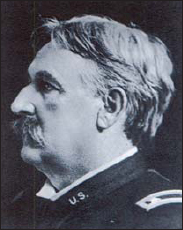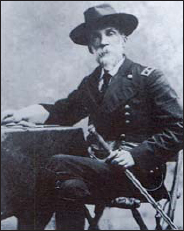
Labelled a ‘splendid little war’ by Senator John Hay, the Spanish American War was a strange event in US history, caused as much by the newspapers as by political events. In 1897, support for Cuban insurgents fighting for independence from Spain was widespread in the United States, and was fuelled by the ‘yellow press’ in a bid to sell newspapers. When a journalist told William Randolph Hearst that there was no real war in Cuba, Hearst replied: ‘You supply the story. I’ll supply the war.’

Gen. William R. Shafter, commander of the V Corps, the United States expeditionary force to Cuba. Obesity and fatigue prevented him taking an active part in the battle, and he was subsequently pilloried by both fellow officers and the press. (Library of Congress)
In early 1898 the USS Maine was sent from Key West to Havana to help protect US citizens in the city. At 9:40pm on 15 February the battleship was ripped apart by a massive explosion, which cost the lives of over 250 American sailors. A court of inquiry would later blame the disaster on the explosion of a mine under the ship. The Spanish were the likely culprits.
Over the next two months both sides mobilised their armed forces and called for volunteers. The US Congress voted for a war budget, and President McKinley demanded that Spain sign an armistice with the Cubans and allow the United States to mediate. The Spanish refused. Congress then passed a resolution backing Cuban independence, and Spain broke off diplomatic relations. On 21 April the US Navy left Key West to impose a blockade of Cuba. Spain therefore declared war, and the United States officially declared war in retaliation on 25 April 1898.
What followed was one of the strangest campaigns in military history, one of a number of unusual campaigns in the Pacific and the Caribbean. The Santiago campaign was fought by two armies who both seemed to defy military logic at every turn. The organisation and supply of the American army was reminiscent of the British in the Crimean War. For their part, the Spanish commanders were more alarmed by a few hundred guerrillas in the rear than by a large modern army advancing to its front. The battle of San Juan Hill, on 1 July 1898, was fought without direction, with decisions made by privates and junior officers setting the course of the battle. The farce continued over the following weeks, when surrender talks dragged on as both parties seemed more influenced by saving face and the reaction of the press than by the military situation. ‘Teddy’ Roosevelt later called the campaign ‘a bully affair’. ‘Bully’ was an apt term.

Gen. Joseph ‘Fighting Joe’ Wheeler, commander of the Cavalry Division, US V Corps. A former Confederate general, Wheeler performed with evident skill and zeal during the campaign, despite his age and frailty. (Library of Congress)
Within months of the outbreak of war, the Spanish would lose their possessions in Cuba, the Philippines, Puerto Rico, Saipan and Guam. The war marked the end of Spanish sovereignty in her ‘New World’, and saw the establishment of the United States as a world power.